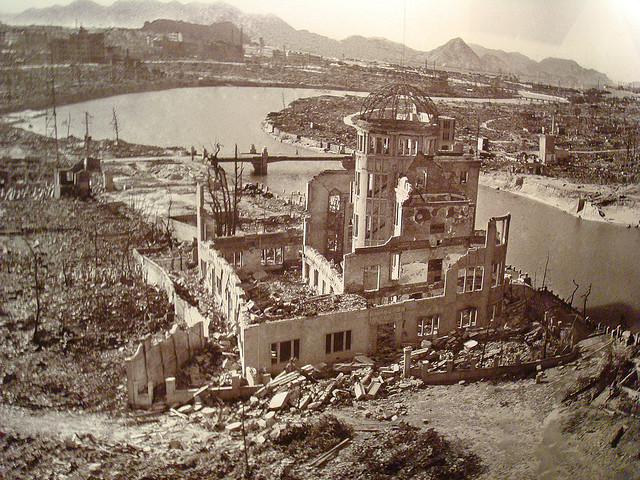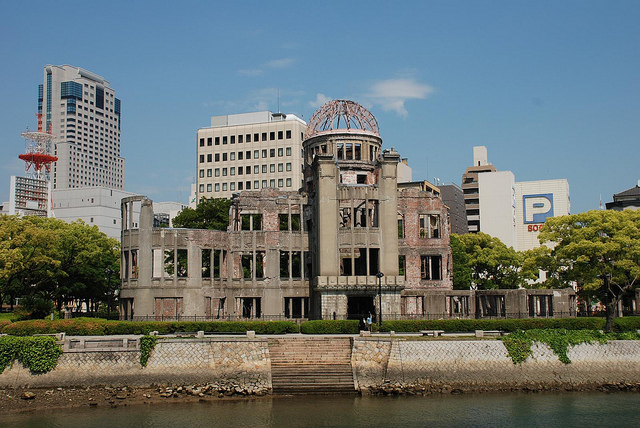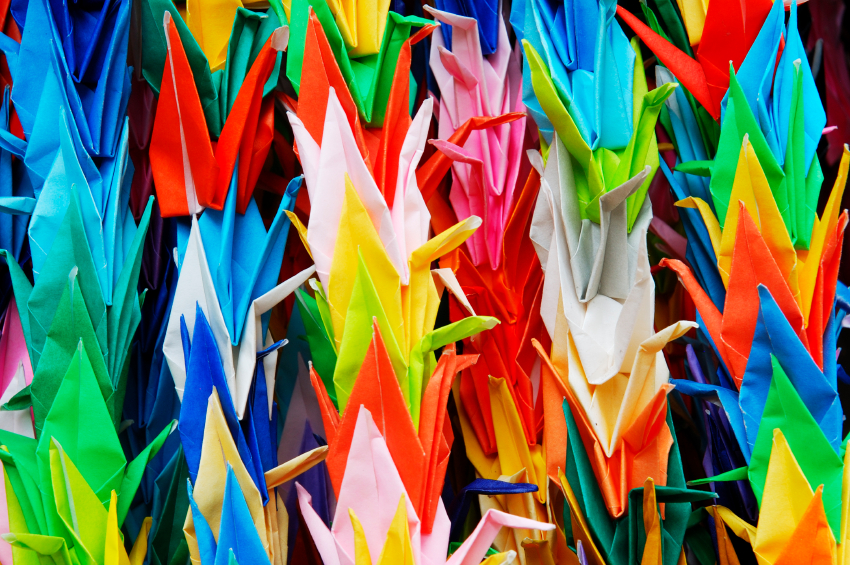Resources to commemorate the atomic bombings at Hiroshima and Nagasaki
Background

On 6th August 1945, at 8.15am, the bustling city of Hiroshima was destroyed by the world's first atomic bomb attack. Three days later, on 9th August, the city of Nagasaki was similarly razed to the ground.
Hundreds of thousands of people, mostly civilians, lost their lives, and many of those who survived were sentenced to an existence of unimaginable physical and emotional suffering. Burns, cancers and other radiation-induced illnesses were compounded by post-traumatic stress disorder and terrible birth defects that still continue today.

The survivors of the bombings are known as Hibakusha and many of them still work tirelessly, as part of the peace community that has sprung from the ashes of Hiroshima and Nagasaki. They tell their stories in an effort to ensure that no one else will ever suffer as they did. The number of Hibakusha is decreasing all the time, with fewer than 100,000 remaining. Soon they will be gone, no longer able to ensure their stories are told.
There are 16,400 nuclear weapons on the earth today.
Using the resources
These resources consist of two short items to remind people about what happened in August 1945 in Hiroshima and Nagasaki – a child’s testimony and a poem – plus prayers and a symbolic activity. There are also links to websites where you will find further information and ideas. Some of these are particularly suitable for a more extended session with children and young people.
The most appropriate time to use the resources would be on one of the two Sundays either side of the date of the commemoration. Here are a few ways you could use them:
- Integrate prayers into your regular Sunday worship.
- Include a short act of remembrance in your Sunday worship using the poem or testimonial, some of the prayers and the Simple worship activity. Alternatively, hand out the paper crane shapes from the Simple worship activity as people leave and invite them to decorate the cranes and display them at home as a reminder.
- The resources, plus materials from the Further resources section could be worked into a reflective and prayerful evening service.
- Include some of the prayers on your weekly bulletin, church website, etc.
In their words…
Testimony of Yoshitaka Kawamoto, aged 13 in 1945
‘One of my classmates, I think his name is Fujimoto, he muttered something and pointed outside the window, saying, "A B-29 is coming." He pointed outside with his finger. So I began to get up from my chair and asked him, "Where is it?" Looking in the direction that he was pointing towards, I got up on my feet, but I was not yet in an upright position when it happened. All I can remember was a pale lightening flash for two or three seconds. Then, I collapsed. I don t know much time passed before I came to. It was awful, awful. The smoke was coming in from somewhere above the debris. Sandy dust was flying around. I was trapped under the debris and I was in terrible pain and that's probably why I came to. I couldn't move, not even an inch. Then, I heard about ten of my surviving classmates singing our school song. I remember that. I could hear sobs. Someone was calling his mother. But those who were still alive were singing the school song for as long as they could. I think I joined the chorus. We thought that someone would come and help us out. That's why we were singing a school song so loud. But nobody came to help, and we stopped singing one by one. In the end, I was singing alone.’
Extract taken from www.inicom.com/hibakusha
Hiroshima Child
I come and stand at every door
But none can hear my silent tread
I knock and yet remain unseen
For I am dead for I am dead
I'm only seven though I died
In Hiroshima long ago
I'm seven now as I was then
When children die they do not grow
My hair was scorched by swirling flame
My eyes grew dim my eyes grew blind
Death came and turned my bones to dust
And that was scattered by the wind
I need no fruit I need no rice
I need no sweets nor even bread
I ask for nothing for myself
For I am dead for I am dead
All that I need is that for peace
You fight today you fight today
So that the children of this world
Can live and grow and laugh and play.
Nazim Hikmet
Find out more about the poet.
Translations of the poem have been set to music by singers and bands.
Prayers
Dear God,
Let us join today as one with the people of Hiroshima and Nagasaki
as they mourn their dead and honour their land.
Let us echo their voices as they call for peace.
Let us acknowledge our common humanity,
and give thanks for their courage and humility
in forgiving the trespasses of their persecutors
and owning their own part in the atrocities that shattered their world.
Let us pray that we may know such courage and humility,
and give thanks that we have not had to experience such suffering to find it.
Amen.
Forgive the human race, O Lord, for its desire to kill.
For placing more importance on the love of power than on the power of love.
For using your gifts – such as nuclear energy – for evil instead of good.
For turning away and denying our responsibility for the protection of your creation.
Forgive us for our complacency;
grant us the eyes to see what is right, and the voice to decry what is wrong.
For Jesus’ sake, and the sake of all humanity.
Amen.
Dear Lord, we gather here today to pray for those who died when the first atomic bombs destroyed Hiroshima and Nagasaki, and for those who survived.
We remember those who died in the days, months and years to come, as they wasted away, bewildered and tormented by the ravages of radiation. We pray for those who lived to bear the physical and mental scars of their unprecedented suffering.
We pray for those still alive today: for the courageous souls who toil for peace, so that no one else may ever suffer what they’ve known; and for those too badly damaged to ever recover, hoping for death to replace the living death they have endured.
We pray for all those who live in lands affected by nuclear testing: the children born deformed and limbless; the cancer-sufferers and their loved ones; the couples who remain childless, too fearful of the risks to the children that may be.
We pray for those in power, that they may acknowledge the consequences of possessing and maintaining nuclear arms and show restraint in the ongoing expansion of nuclear capabilities.
We pray for ourselves and our communities, joining as one voice with the survivors, the Hibakusha of Japan, in praying for peace throughout the world.
We make these prayers in Jesus’ name, the Prince of Peace.
Amen.
Simple worship activity
The origami crane is a symbol of peace in Hiroshima, and many hundreds of thousands are made throughout the world each week and delivered to the Peace Memorial Park to commemorate the children who died in the atomic bombing. The story of the paper cranes comes from 10 years after the bombing when Sadako Sasaki, a 12-year-old, was dying of leukaemia. A friend of hers told her an old Japanese legend that says if you make one thousand cranes, you can make a wish. Sadako immediately started making the cranes and made 644 before she died. A memorial was set up to remember her and all the other children who died.

Distribute the paper crane outlines and invite people to colour them brightly and creatively. Provide scissors so that they can be cut out. They could be arranged as a combined work of art and symbol of empathy and solidarity with the people of Hiroshima and Nagasaki, and others across the globe who long for a more peaceful world. Alternatively invite people to take their crane home as a reminder and focus for prayer.
The full story of Sadako plus other resources and instructions for making origami cranes can be found in the story of the peace crane.
Another way of presenting Sadako's story would be to play an excerpt from Tony Biggin's work scored for soloists, chorus and orchestra, The Gates of Greenham. 'Part 6 August 6th' tells the story of Sadako and is available to stream on Apple Music.
Further resources
Additional resources, information and testimonies:
Links to other websites are for the convenience of users only and do not constitute any endorsement or authorisation by ROOTS for Churches Ltd.
These materials were collected and written by Tam Martin Fowles, a therapist and teacher, and founder of Hope in the Heart, an organisation seeking to inspire people to overcome adversity, live with compassion, and understand their place in the global community. Find out more at www.hopeintheheart.org.